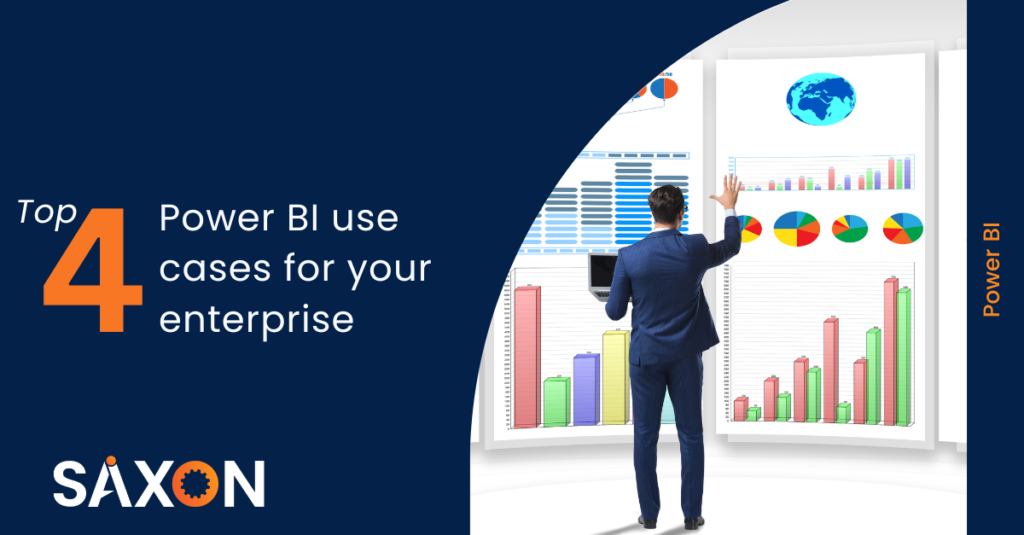Businesses deal with an enormous amount of data every day. Nonetheless, if the enterprise is unable to connect and tap into that vital information, it will not generate much. The circumstances are such that you are preventing your own enterprise from getting value from the data that you have. Thus, accessing the immense potential of the enterprise data and timely sharing the insights are immensely important. This is where Microsoft Power BI is invaluable and advantageous. It aids in the task of data visualization and timely sharing. In this blog, let me take you through some of the top 4 use cases of Power BI that you can use in your enterprise to help it flourish.
What is Power BI?
Microsoft Power Platform’s business intelligence component, Power BI, enables end-users to visualize data from their connected systems. Moreover, the fact that the desktop version of the program is free means even small firms on a low budget can gain an advantage from the data visualization.
Power BI service is a cloud service hosted by Microsoft that is secure and allows users to see dashboards, reports, and Power BI apps using a web browser or through mobile apps for Windows, iOS, and Android. Additionally, you will see three different software versions on the Power BI pricing page- Power BI Free or Desktop, Power BI Pro, and Power BI Premium.
Top 4 Power BI use cases for an enterprise
As a business leader, you may wonder how one can use Power BI easily or design dashboards and reports that are eye-catching and comprehensible so that they can support making wise, data-driven business decisions. Let us look at a few use cases where enterprise Power BI dashboards and reports can alter how we look at data.
1. Management of resources
2. Finance Reporting
3. Sales
4. Claims, billing, and collection report
Resource Management
Let us take the instance of a manufacturing business. The enterprise has multiple manufacturing sites and production facilities in different geographical regions. In such a scenario, a customized dashboard is the best way to manage resource allocation and make improved decisions. Here, the visualization abilities of Power BI are powerful. They can generate the report using Power Query and Power Pivot in Excel. However, for an effective and thorough picture of demand and allocation of resources, Power BI can monitor the following critical KPIs:
1. The number of active projects and resources allotted.
2. Task-counting resources
3. The characteristics and skills of resources
4. The percentage of project completion.
Finance reporting dashboards
Whichever industry you are in, your enterprise’s main KPI will likely be producing revenue and profit. Keeping track of expenses through long-term Excel spreadsheets or logbooks can get tedious and overwhelming. As you manually update the numbers in the cells, you inevitably begin to lose track. So, enterprises in the modern day have shifted to the potent data visualization program known as Power BI.
Let us demonstrate with an example. For an enterprise selling a particular category of devices, creating a PoC or Proof of Concept for its financial reporting dashboard is an excellent way to simplify. Because of a single dashboard, the company’s intricate financial spreadsheets are easy to understand. Since it gives a bird’s-eye perspective of their revenue statements, the enterprise can make swift judgments based on the information about cash flow and product-specific sales summaries.
Sales scorecard
Which is the simplest way of keeping tabs on the health of the business? It is through the Sales Scorecard. The scorecard or dashboard gives the sales staff a high-level view of what happened with the business the day before and how things are doing overall. Managers can compare the performance of their sales teams by zone and check the entire scorecard of their team.
Users can review the reports in-depth by examining the scorecard for each team member, product performance, or even geographic or temporal sales. Nearly all business types need to use sales and marketing scorecards, and we realize that tailoring them to your needs is as crucial to producing the results you need. At any moment, you can do further customization as well as have access to Power BI dashboards.
Billing, claims, and collection report
The foundation of excellent customer management is quick and efficient claim handling. Any industry that processes claims can benefit from using Power BI to enhance the claims management process—the analytics assist in identifying claim trends and loss patterns while lowering the likelihood of fraud and inefficiency. The claims handlers’ team can optimize the claims and billing process by accelerating the entire process, reducing losses, and raising client satisfaction. Besides this, claim cancellation and collection delay are two significant challenges that must be resolved right away in order to satisfy clients and provide the necessary efficiency to the process.
How can we help?
As a business leader, if you are contemplating integrating a BI platform in your enterprise, we suggest giving Microsoft Power BI a chance. The Power BI use cases demonstrated here are practical solutions for any enterprise. At Saxon, we provide business intelligence solutions, supporting you across all the stages of the process, from research to development to deployment and, ultimately, your unceasing success as InsightBox. If you want to learn more about Insightbox, which is based on the Power BI platform, contact us below; we would be delighted to help you.

